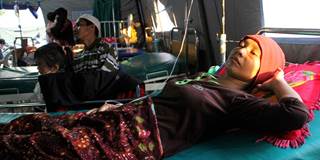After decades of progress in the fight to contain one of the world’s greatest health threats, malaria infection rates are creeping up again. To curb the spread of drug-resistant strains to already-affected regions – particularly Sub-Saharan Africa – the world needs a new, globally coordinated strategy.
SMITHFIELD, RHODE ISLAND/HANOI – When it comes to fighting infectious diseases, progress cannot be gauged by the availability of resources; the most important metric is the number of lives saved. By this measure, the world is on the verge of losing its battle with malaria.
After years of impressive gains, global efforts to combat the mosquito-borne illness have stalled. According to the World Health Organization’s most recent malaria report card, 219 million cases were reported in 2017, an increase of three million from the previous year. Moreover, while total annual deaths remained essentially unchanged at about 435,000, declines in some regions reversed.
More alarming, the death toll could climb far higher. Data from the Consortium for Health Action – a nonprofit group committed to eliminating incurable malaria in Southeast Asia – shows a high risk of drug-resistant malaria spreading from Asia to Sub-Saharan Africa, the world’s most malaria-affected region. This is not an unprecedented concern. In the late 1950s, resistance to the anti-malarial drug chloroquine emerged in Cambodia and spread to (and throughout) Africa during the 1980s, resulting in a two- to sixfold increase in malaria-related mortality. Without urgent and coordinated interventions, it could happen again, but much faster this time.

SMITHFIELD, RHODE ISLAND/HANOI – When it comes to fighting infectious diseases, progress cannot be gauged by the availability of resources; the most important metric is the number of lives saved. By this measure, the world is on the verge of losing its battle with malaria.
After years of impressive gains, global efforts to combat the mosquito-borne illness have stalled. According to the World Health Organization’s most recent malaria report card, 219 million cases were reported in 2017, an increase of three million from the previous year. Moreover, while total annual deaths remained essentially unchanged at about 435,000, declines in some regions reversed.
More alarming, the death toll could climb far higher. Data from the Consortium for Health Action – a nonprofit group committed to eliminating incurable malaria in Southeast Asia – shows a high risk of drug-resistant malaria spreading from Asia to Sub-Saharan Africa, the world’s most malaria-affected region. This is not an unprecedented concern. In the late 1950s, resistance to the anti-malarial drug chloroquine emerged in Cambodia and spread to (and throughout) Africa during the 1980s, resulting in a two- to sixfold increase in malaria-related mortality. Without urgent and coordinated interventions, it could happen again, but much faster this time.